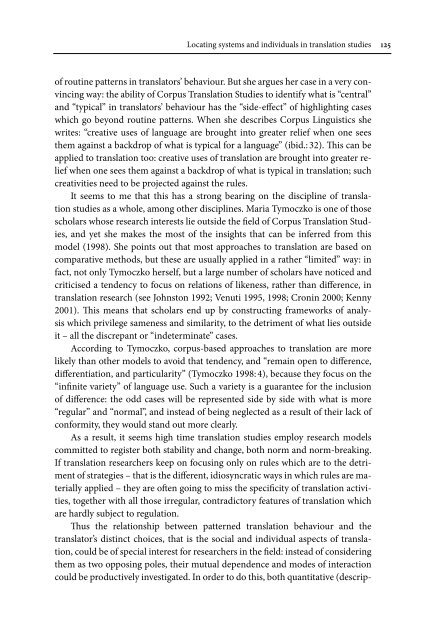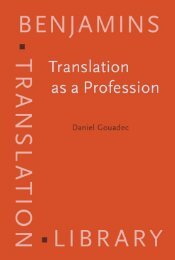Constructing a Sociology of Translation.pdf
Constructing a Sociology of Translation.pdf
Constructing a Sociology of Translation.pdf
- No tags were found...
Create successful ePaper yourself
Turn your PDF publications into a flip-book with our unique Google optimized e-Paper software.
Locating systems and individuals in translation studies 125<strong>of</strong> routine patterns in translators’ behaviour. But she argues her case in a very convincingway: the ability <strong>of</strong> Corpus <strong>Translation</strong> Studies to identify what is “central”and “typical” in translators’ behaviour has the “side-effect” <strong>of</strong> highlighting caseswhich go beyond routine patterns. When she describes Corpus Linguistics shewrites: “creative uses <strong>of</strong> language are brought into greater relief when one seesthem against a backdrop <strong>of</strong> what is typical for a language” (ibid.: 32). This can beapplied to translation too: creative uses <strong>of</strong> translation are brought into greater reliefwhen one sees them against a backdrop <strong>of</strong> what is typical in translation; suchcreativities need to be projected against the rules.It seems to me that this has a strong bearing on the discipline <strong>of</strong> translationstudies as a whole, among other disciplines. Maria Tymoczko is one <strong>of</strong> thosescholars whose research interests lie outside the field <strong>of</strong> Corpus <strong>Translation</strong> Studies,and yet she makes the most <strong>of</strong> the insights that can be inferred from thismodel (1998). She points out that most approaches to translation are based oncomparative methods, but these are usually applied in a rather “limited” way: infact, not only Tymoczko herself, but a large number <strong>of</strong> scholars have noticed andcriticised a tendency to focus on relations <strong>of</strong> likeness, rather than difference, intranslation research (see Johnston 1992; Venuti 1995, 1998; Cronin 2000; Kenny2001). This means that scholars end up by constructing frameworks <strong>of</strong> analysiswhich privilege sameness and similarity, to the detriment <strong>of</strong> what lies outsideit – all the discrepant or “indeterminate” cases.According to Tymoczko, corpus-based approaches to translation are morelikely than other models to avoid that tendency, and “remain open to difference,differentiation, and particularity” (Tymoczko 1998: 4), because they focus on the“infinite variety” <strong>of</strong> language use. Such a variety is a guarantee for the inclusion<strong>of</strong> difference: the odd cases will be represented side by side with what is more“regular” and “normal”, and instead <strong>of</strong> being neglected as a result <strong>of</strong> their lack <strong>of</strong>conformity, they would stand out more clearly.As a result, it seems high time translation studies employ research modelscommitted to register both stability and change, both norm and norm-breaking.If translation researchers keep on focusing only on rules which are to the detriment<strong>of</strong> strategies – that is the different, idiosyncratic ways in which rules are materiallyapplied – they are <strong>of</strong>ten going to miss the specificity <strong>of</strong> translation activities,together with all those irregular, contradictory features <strong>of</strong> translation whichare hardly subject to regulation.Thus the relationship between patterned translation behaviour and thetranslator’s distinct choices, that is the social and individual aspects <strong>of</strong> translation,could be <strong>of</strong> special interest for researchers in the field: instead <strong>of</strong> consideringthem as two opposing poles, their mutual dependence and modes <strong>of</strong> interactioncould be productively investigated. In order to do this, both quantitative (descrip-
















